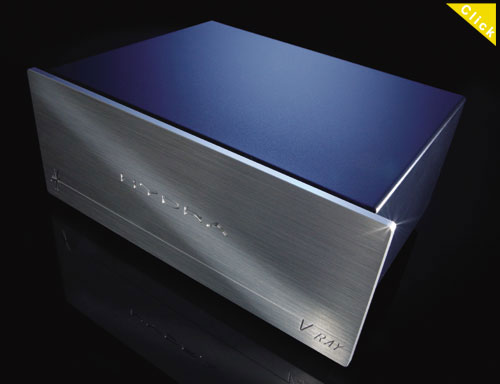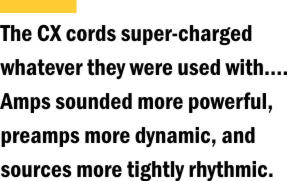Shunyata Research • CX-Series Power Cords and Hydra V-Ray Version II Power Conditioner
ver ten years ago, Caelin Gabriel literally founded Shunyata Research on the sonic strengths of his power cords -- thick, unwieldy things named after venomous snakes. A decade later, Shunyata Research has become a case study in building an audio company the right way. Caelin and Grant Samuelsen, Shunyata's director of sales and marketing, decided early on to aim for long-term success, creating a brand with worldwide renown whose distribution network and brick-and-mortar dealer base are the envy of companies that have been in existence much longer.
Such savvy business decisions are irrelevant without the products to support them, however, and here Shunyata Research has also shone, earning a well-deserved purist reputation for its power cords and power conditioners. I've used both for years, delighted with their performance with a diverse array of electronics, and Caelin has worked steadily to improve them, a goal he's reached every time out, even as the materials and geometries he's employed have changed. Grant Samuelsen calls Caelin as "an inventor," not a "cable designer," because of his intrinsic restlessness. I'm sure he's also called Caelin other things when he's announced some new discovery he's dreamed up that Grant must then shoehorn into the Shunyata product line. Shunyata's power cords have undergone at least four major revisions, leading to the latest versions in the CX series. The most important change here is with the conductors themselves. There are many more of them, comprising greater physical mass than with the earlier cords. For instance, the Anaconda Helix, which was Shunyata's previous top of the line, had 17 conductors comprising an 8AWG cable. The Anaconda CX has 450 conductors and is a 7AWG cable. The new top-of-the-line King Cobra CX has a whopping 600 conductors and is 5AWG. Its bulk is obvious when you pick it up. The Python CX has 280 conductors, comprising a 9AWG cable. All Shunyata power cords retain their large diameters, due to the tube in which the conductors reside, but they are surprisingly flexible given their thickness. You might be thinking, as I was, that all these additional conductors are actually bundles of bare wires comprising the same mass as the former solid-core conductors, but that's not the case. Each is individually insulated. Previous Shunyata cords were built completely by hand, as the company's counter-rotating Helix geometry was too complex for any machine to produce. That's not the case any longer, as, paradoxically, the greater number of CX-series conductors are "layered," in Shunyata's terminology, into counter-rotating helices by machine, minimizing capacitance and inductance and creating, I'm convinced, the cable's sonic fingerprint. Shunyata uses CDA-101 copper, the purest available, for its conductors, which are cryogenically treated onsite to -310 Fahrenheit. Connectors are Shunyata's own SR-ZP plug and IEC, which omit dyes, carbon and ferrous metals that, Shunyata feels, degrade performance. Also omitted is the FeSi-1000 compound that rattled around inside some of Shunyata's earlier power cords, along with the distinction between the non-compound-using Alpha and compound-using Vx cords. I asked Grant Samuelsen about this once-defining feature, and his answer was simple and straightforward: "It's no longer needed because of the massive conductor bundles and the improvement they brought." The Hydra V-Ray Version II also eschews the use of the FeSi-1000 compound in the first version of the product, replacing it with a completely new one dubbed ZrCa-2000, whose transparency Grant Samuelsen praises. The filter network, a 24-element capacitive array, represents a reworked version from that used in the original V-Ray, and a new bus system made of CDA-101 copper is said to improve resolution "by reducing eddy-currents and waveform reflections." Like the original V-Ray, the Version II is completely passive. It doesn't regenerate or reconstitute the AC coming from the wall. Instead, it scrubs it clean as it passes through. A holdover from the original V-Ray is Shunyata's Trident Defense System, which addresses power surges, power spikes and over-current conditions. The chassis and outlets also remain, making it possible to have an older V-Ray upgraded, which amounts to a complete rebuild. It costs $1500 -- the difference in price between the two units plus the labor involved. A proper evaluation hunyata Research sent me two each of the King Cobra, Anaconda and Python CX power cords, along with a Hydra V-Ray II and a longer King Cobra to use with it. Such a cornucopia of products would have been laborious to review when Shunyata was still producing two versions of each power cord, as part of the review process would have involved discovering which cord worked best with each piece of equipment. I still did some of that with the CX cords, settling on a combination that maximized the performance of them all, but I didn't have to go to the same lengths. I did, however, incorporate everything into my system systematically, so I could assess the sonic effect of each power cord with and without the V-Ray II. Of course, my system changed over the course of this time, so I also used the Shunyata products with different amps, preamps CD players and phono stages. The permutations and combinations were staggering. Shunyata supplied me with review samples nearly a year ago, and I'm grateful that Grant Samuelsen was patient, as the extra time definitely gave me greater insight into the CX cords and V-Ray II. The only products listed below as part of my system with which I didn't use the power cords were the Audio Research Reference 5, Reference Phono 2 and Reference 110, which all have 20-amp IEC inlets. The 15-amp power cords I received wouldn't work with them. Of course, Shunyata does make 20-amp versions. Power cord "sound" hat some audiophiles hear "a sound" with aftermarket power cords in their systems is considered a sign of high-end audio's nonsensical mysticism by some laypeople, the sonic equivalent of alchemy. I can honestly say that I was among those skeptics many years ago, believing that a length of wire through which no musical signal passes and coming at the end of miles of power lines couldn't possibly have any effect, let alone a positive one. AC power is AC power, I reasoned. However, just like "bits are bits," there is no unerring law where musical reproduction is concerned. I did my own experiments years ago, not only listening to different power cords but also making a few cords of my own. That each changed the sound was evident -- my DIY cords clearly changed it for the worse, in fact. That some of them improved the sound in meaningful ways was just as evident, proving the complexity of AC's effect on sonic performance. Materials and construction details show that the Shunyata CX power cords are complex themselves. In fact, they might be the most complex in all of high-end audio. Hundreds of conductors each precisely placed, cryogenic treatment, bespoke connectors -- these are the features of extreme power cords to be sure. The Hydra V-Ray is no less over the top, with its two dozen filters, noise-killing compound and surge/spike protection. I mention all this as a preamble to my comments on performance, which proved to be rather unexpected. Again, I've used Shunyata power cords along with various versions of the original Hydra and the first version of the V-Ray for years. I thought the previous Helix cords were the best I'd ever heard, especially the Anaconda Alpha, which extended the bandwidth of my system, likely through lowering the noise floor to a new level. Because of this, I expected the CX cords to offer further refinement of the core Shunyata character -- evolution not revolution, in other words.
Sometimes the forcefulness was surprising, as when I first listened to the reissued LP of Nirvana's seminal Nevermind [DGC/Original Recordings Group ORG 032]. This snarling music demands to be played at 11, although with a full complement of Shunyata cords and a V-Ray II in the system, it retained its power and propulsiveness even at less-than-headbanging levels. The system's volume was reduced, but the music's power and rowdiness were not. I don't own an original DGC pressing of this album, but I do have a European reissue [Universal International 424 425-1], and the differences between it and the ORG LP, which was pressed on blue vinyl, were all the more apparent thanks to the Shunyata power products. The ORG LP sounded slightly more liquid and natural, less dominated by Butch Vig's squeaky-clean production. While the Nirvana LPs illustrated that it was at the low level of the dynamic spectrum that the Shunyata power cords and V-Ray II did their best work, a number of less raucous recordings displayed this even better. When it comes to contemporary jazz pianists, I am a great admirer of Brad Mehldau, but I also like the more cerebral approach of some of the Scandinavians, such as Tord Gustavsen and someone unknown to me until a couple of months ago, Mathias Landæus. Opening [MA Recordings M081A] is Landæus 's debut CD on the MA Recordings label, which is known mostly for its diverse catalog of world music captured with purist recording techniques. Opening is contemporary piano-trio jazz -- out of place among the other MA releases, but a musical gem nonetheless. It conveys the instruments' presence and the venue's inherent spaciousness; it's the sort of recording that sounds its best on a system with an inky-black background. The Shunyata products provided this, the musical signal better delineated from the noise floor, which seemed nonexistent. The piano notes trailed off into nothingness like wisps of smoke blown by the wind. ECM recordings often sound this way, but they are more arid, sometimes to the point of brittleness. Opening is far better balanced -- perhaps even ideally balanced -- and the music is intellectually engaging, as is that of so many ECM recordings. The Shunyata cords covered all of the musical bases, displaying neither tonal shift nor dynamic compression in the process. Top to bottom, the presentation had a uniformity that highlighted or detracted from no region. This was a holdover from the earlier Shunyata Alpha cords and Hydra power conditioners, whose evenhandedness never turned them into products to be used only in certain applications or with certain electronics. However, I did encounter one surprise when I used a Python CX with my TW-Acustic turntable. I did this almost without thinking about it -- grabbing the cord after using the stock cord that came with the 'table to power a Genesis Digital Lens. A day later, when I spun a few records, I immediately noticed that something was different -- and better. There was an improved sense of rhythmic momentum, the bass line of the Blue Note LP I was playing, Sonny Rollins' great Vol.1 [Blue Note/Music Matters MMBLP-1542], sounding snappier and more precise as tempos shifted from cut to cut. I then remembered the Python CX and pondered how it could be doing what it obviously was. Like the power cords, the turntable isn't technically in the signal path, yet its motor obviously benefits from the use of a good power cord. I mentioned this to Grant Samuelsen, who posited a plausible explanation: the turntable motor radiates noise back into the AC line, exactly what the Python CX rejects. Now to the eternal questions -- which cord is best where, and how to appraise the effect of the V-Ray II. As I've mentioned, Shunyata's previous Alpha and Vx variants were designed with particular types of equipment in mind, while the CX cords are meant to be universal. Still, even within the CX line, there are good and better uses for each cord. Perhaps because of its sheer bulk, the King Cobra CX cords were better on amplifiers than either the Anaconda or Python, though not by a tremendous margin. Instrumental lines were a bit easier to follow, and the bass had greater weight and sock. I used the Python with source components -- analog and digital -- and the Anaconda with preamps, where it brought about a small increase in tonal purity compared to the Python.
And in case you were wondering, comparing the latest Shunyata cords to the older Helix ones only underscored the superiority of the CX cords, and by no hard-to-detect margin. I can imagine instances where a Python or Anaconda Vx would be the choice for use with a particular digital player or transport, especially one that's inherently lean-sounding, but I didn't encounter any such instance myself. This would be a matter of one piece of gear needing the corrective effect of Shunyata's FeSi-1000 compound. Even with the pieces of gear the Vx cords worked well previously, like my Ayre C-5xeMP universal player, any of the CX cords was the new easy-to-hear choice. Measuring success s is common in high-end audio, Shunyata Research has endeavored to quantify the effectiveness of its products through measurements. Specifically, this means measuring the amount of instantaneous current flow of a power product over the course of a few milliseconds, what Shunyata has termed "DTCD," for "Dynamic Transient Current Delivery." Shunyata's measurements show that even one of its low-cost Venom power cords handily beats a generic black power cord and a run-of-mill power strip, which reduce DTCD by up to 40% and even cause a slight sag in AC voltage. I saw no measurements on Shunyata's CX power cords, but their performance speaks loud and clear -- literally. I was constantly delighted when they were part of my system -- any part, either providing power to high-current Lamm amps or my turntable's DC power supply. They are not inexpensive, especially the King Cobra CX, which costs as much as a good CD player, but it would be hard to think that they are not worth their prices after you've heard what they can do -- especially the Python CX, which maximizes the price-performance equation. And this goes all the more for the Hydra V-Ray Version II, which I sorely do not want to be without, no matter with which power cords it's used. It seems like a long shot that a company could be
successful by making thick, intricate, expensive power cords, but that's just what
Shunyata Research has done. With its CX power cords and Hydra V-Ray II, Shunyata Research
has reaffirmed its goal of doing things the right way.
|


 But that wasn't the case.
The CX cords super-charged whatever they were used with (including my turntable -- more to
come on that). Amps sounded more powerful, preamps more dynamic, and sources more tightly
rhythmic. And used together, all of the cords and the V-Ray II simply made for a more
forceful and gutsy sound, as though the components were mainlining AC power. Noise was
ever lower, making the signal seem even more prominent. Removing just one of the CX cords
and returning to one from the previous generation reduced the sense of boundless energy a
little or, with a few cord-equipment combinations, a lot.
But that wasn't the case.
The CX cords super-charged whatever they were used with (including my turntable -- more to
come on that). Amps sounded more powerful, preamps more dynamic, and sources more tightly
rhythmic. And used together, all of the cords and the V-Ray II simply made for a more
forceful and gutsy sound, as though the components were mainlining AC power. Noise was
ever lower, making the signal seem even more prominent. Removing just one of the CX cords
and returning to one from the previous generation reduced the sense of boundless energy a
little or, with a few cord-equipment combinations, a lot. While you can throw money
at the issue and simply buy King Cobras to use all around, prudence is more satisfying.
For me, that would mean a King Cobra CX on the amp, Pythons on the source components, and
an Anaconda on the preamp. However, this assumes the addition of the V-Ray II, which I
consider to be the most important of all of the products. I experimented with it and power
cords from other makers, as well as previous versions of the Shunyata cords, and in each
case it proved its crowning worth, anchoring the sense of unfettered dynamics and rhythmic
precision that began at the very noise floor. Thus, if you're thinking about where to
begin or spend the lion's share of your budget, the V-Ray II is it.
While you can throw money
at the issue and simply buy King Cobras to use all around, prudence is more satisfying.
For me, that would mean a King Cobra CX on the amp, Pythons on the source components, and
an Anaconda on the preamp. However, this assumes the addition of the V-Ray II, which I
consider to be the most important of all of the products. I experimented with it and power
cords from other makers, as well as previous versions of the Shunyata cords, and in each
case it proved its crowning worth, anchoring the sense of unfettered dynamics and rhythmic
precision that began at the very noise floor. Thus, if you're thinking about where to
begin or spend the lion's share of your budget, the V-Ray II is it.